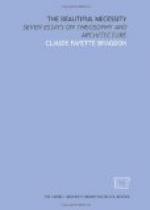A natural deduction from these facts is that relations of architectural length and breadth, height and width, to be “musical” should be capable of being expressed by ratios of quantitively small numbers, preferably an odd number and an even. Although generally speaking the simpler the numerical ratio the more perfect the consonance, yet the intervals of the fifth and major third (2:3 and 4:5), are considered to be more pleasing than the octave (1:2), which is too obviously a repetition of the original note. From this it is reasonable to assume (and the assumption is borne out by experience), that proportions, the numerical ratios of which the eye resolves too readily, become at last wearisome. The relation should be felt rather than fathomed. There should be a perception of identity, and also of difference. As in music, where dissonances are introduced to give value to consonances which follow them, so in architecture simple ratios should be employed in connection with those more complex.
[Illustration 89]
Harmonics are those tones which sound with, and reinforce any musical note when it is sounded. The distinguishable harmonics of the tonic yield the ratios 1:2, 2:3, 3:4, 4:5, and 4:7. A note and its harmonics form a natural chord. They may be compared to the widening circles which appear in still water when a stone is dropped into it, for when a musical sound disturbs the quietude of that pool of silence which we call the air, it ripples into overtones, which becoming fainter and fainter, die away into silence. It would seem reasonable to assume that the combination of numbers which express these overtones, if translated into terms of space, would yield proportions agreeable to the eye, and such is the fact, as the accompanying examples sufficiently indicate (Illustrations 87-90).
The interval of the sub-minor seventh (4:7), used in this way, in connection with the simpler intervals of the octave (1:2), and the fifth (2:3), is particularly pleasing because it is neither too obvious nor too subtle. This ratio of 4:7 is important for the reason that it expresses the angle of sixty degrees, that is, the numbers 4 and 7 represent (very nearly) the ratio between one-half the base and the altitude of an equilateral triangle: also because they form part of the numerical series 1, 4, 7, 10, etc. Both are “mystic” numbers, and in Gothic architecture particularly, proportions were frequently determined by numbers to which a mystic meaning was attached. According to Gwilt, the Gothic chapels of Windsor and Oxford are divided longitudinally by four, and transversely by seven equal parts. The arcade above the roses in the facade of the cathedral of Tours shows seven principal units across the front of the nave, and four in each of the towers.




